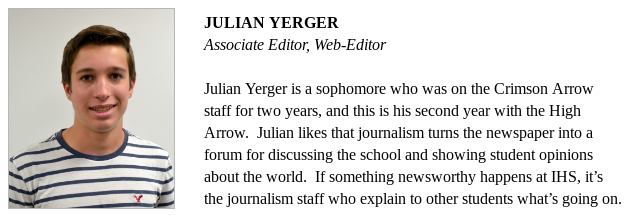JULIAN YERGER – Although most field trips claim to be educational, one stands out above the rest.
Twice per school year, the IHS AP Chemistry class visits the IUP chemistry department for an all-day laboratory experiment using more sophisticated equipment than the high school can afford to offer.
On the university side, the trip was supported by professors Dr. Elcesser and Dr. Kondo. AP Chem is intended to replace a first-year chemistry course and covers the same material, but college level labs are difficult to replace. At 8:00 in the morning on December 13 and January 10 IHS students arrived to begin what was effectively one very long lab.
As in previous years, the experiments performed were too dangerous, elaborate, or time-consuming for a two-period block at school. IHS Junior Aaron Burkhart enjoyed the new opportunities. “My favorite part was participating in the group and trying things that we can’t do at IHS.”
This year, the December lab involved the synthesis of aspirin from acetic anhydride and salicylic acid. First, lab groups modeled all involved molecules using IUP’s WebMO modeling software, then answered questions about how the reaction should theoretically proceed.
After lunch, students measured out and mixed precise amounts of reactants. Since the reaction happened far too slowly to reach completion, a two-step purification process was used to separate the produced aspirin.
The mass of the produced aspirin was then compared to the maximum theoretical yield to determine the efficiency of the process and other experiments were later conducted to determine purity. IHS Senior Vince Birch thought his group did well stating, “Our experiment was successful because we made a lot of high-quality aspirin. We were very proud and surprised by this result.”
For their second trip to IUP, students performed a variety of experiments to explore the link between theoretical molecular properties and measurable qualities. For example, some molecules have imbalanced charges that cause additional attraction forces. In theory, this greater “stickiness” should slow the evaporation rate, increase the surface tension, and affect its characteristics as a solvent.
The data that was collected mostly supported these theories, but there were some surprises. For example, liquids with larger molecules were expected to have higher surface tension, but repulsion forces increased instead.
Although the labs are challenging, most students in the class consider them a fun break from their regular school day.
The IUP labs have been a regular part of the curriculum ever since AP Chem was first offered at IHS, but the experiments are often changed from year to year. Instead of aspirin, a different compound used to be synthesized and measured for purity by shining ultraviolet light on it and watching the color change. However, this compound was discovered to be a potential carcinogen and the lab was dropped.
Before the high school received its own spectrophotometers, IUP’s equipment was used, but these labs are now part of the regular school day.

[Photo by Phil Palko]
Photo Caption: “IHS Senior Vince Birch proudly finishes his group’s experiment and shows off the aspirin they synthesized.”

